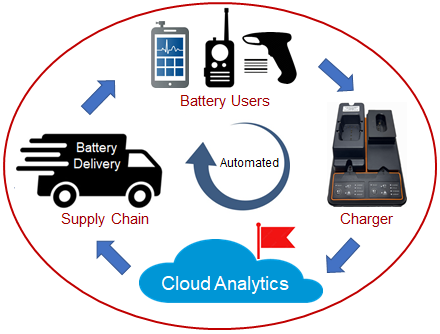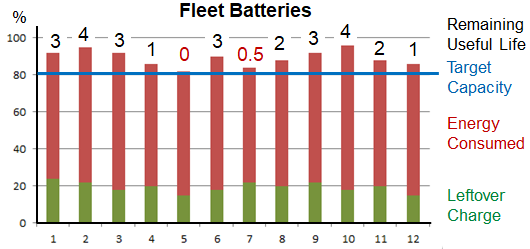April 2024 - Article
|
A dog owner must always have enough dog food. When reserves get low, pressing the Amazon button gets a new bag to keep the dog happy. If this action is possible with such ease on dog food, replacing faded batteries requires equal ease and attention. A new generation of charger is arising that checks the capacity of a smart battery and calls for service or replacement when the Minimum Operational Reserve Energy (MORE) is no longer met. The MORE level in the charger is adjustable to get a sweet-spot between solid reliability and good economics, a feature made possible with the Target Selector. The Universal Supervisor Charger (USC) offers these features in standalone mode and when connected to a host to enable Cloud Analytics. |
 Figure 1: Steadyfood supply with Amazon button |
 Figure 2: SoH Light |
When inserting a smart batteryinto the USC, the charger validates the available capacity with a green SoH Light as shown as in Figure 2; amber calls for calibration or replacement. Battery performance is evaluated by reading the Leftover Charge before charge. An analogy is an aircraft carrying enough fuel for a safe landing. Leftover Charge will also be affected as the battery fades with use and time. |
|
Leftover Charger at the end of a day should be 10–20%. Increasing the target allows more capacity; ample reserve permits lower settings to keep a battery in service longer. Such a system enables full use of each battery with call for replacement before failure. Connecting the USC to a host forms the Battery Endurance Plan (BE- Plan) as shown in Figure 3. The charger serves as ‘Amazon button’ in identifying batteries destined for replacement. The service can be automated by sending batteries just in time through supply chain. |
 Figure 3: Cloud Analytics informs battery users of weak batteries |
Managing Battery InventoryOne of the special features of the USC is checking batteries at user-level. With a lit orange SoH Light, the encumbered battery calls for calibration in the charger or is placed into the Service Box for outside service. Packs that recover ae reinstated; failing packs are replaced or assigned to lesser duties. |
 Figure 4: Rotating batteries in service with new packs |
 Figure 5: Making fleet batteries transparent at a glance. |
Cloud Analytics displays fleet batteries as illustrated in Figure 5 revealing Leftover Charge, Energy Consumed and the Remaining Useful Life (RUL) estimated in years. As can be seen, the Target Capacity setting plays a critical role in the life expectancy of a battery, information that is essential in budgeting and inventory management. |
Conclusion
The Battery Endurance Plan with Cloud Analytics requires that the battery user knows the Minimum Operational Reserve Energy (MORE), a base setting on which Leftover Charge is observed to assess battery performance. Adjustments are made with the Target Selector serving as pass/fail gatekeeper at user-level. This setting assures that all batteries in the arsenal meet a set performance level, made visible to the fleet supervisor with Cloud Analytics. The BE-Plan does this with minimal user intervention as part of routine charging.
